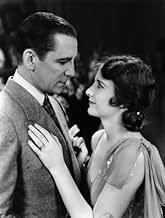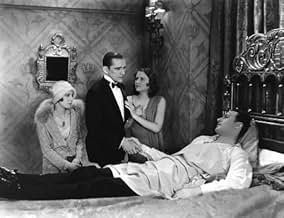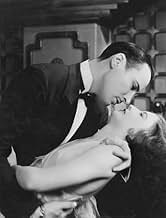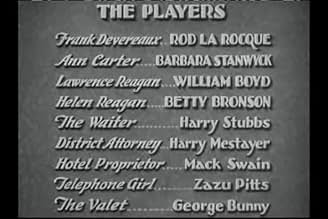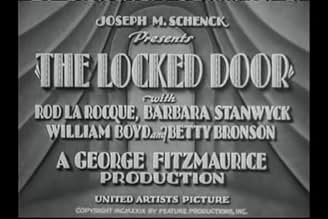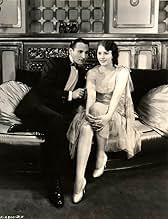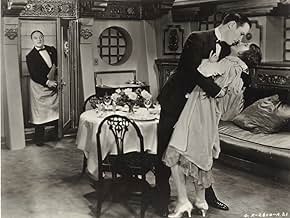AVALIAÇÃO DA IMDb
6,0/10
640
SUA AVALIAÇÃO
Adicionar um enredo no seu idiomaOn her first anniversary, Ann Reagan finds that her sister-in-law is involved with a shady character from her own past, and determines to intervene.On her first anniversary, Ann Reagan finds that her sister-in-law is involved with a shady character from her own past, and determines to intervene.On her first anniversary, Ann Reagan finds that her sister-in-law is involved with a shady character from her own past, and determines to intervene.
- Direção
- Roteiristas
- Artistas
Zasu Pitts
- Telephone Girl
- (as Zazu Pitts)
Mary Ashcraft
- Girl on Rum Boat
- (não creditado)
Violet Bird
- Girl on Rum Boat
- (não creditado)
Earle Browne
- Bit Part
- (não creditado)
Clarence Burton
- Police Officer
- (não creditado)
Lita Chevret
- Girl on Rum Boat
- (não creditado)
Gilbert Clayton
- Bit Part
- (não creditado)
Pauline Curley
- Bit Part
- (não creditado)
Edgar Dearing
- Cop
- (não creditado)
Edward Dillon
- Bit Part
- (não creditado)
Avaliações em destaque
Someone referred to this as "stagy," and was more correct than perhaps he knew: "The Locked Door" was originally a stage play, and this movie was an adaptation, a good one in my opinion.
C. Gardner Sullivan had been writing scenarios and inter-titles since at least 1912, and is honored among aficionados who know his work from those earliest years of motion pictures.
The four top-billed players were also veterans, except for Barbara Stanwyck who has only one previous credit.
Rod La Rocque had been in movies since at least 1914, and put in 12 more years.
Betty Bronson became a huge star with her seventh role, Peter Pan in the movie of that name, and reportedly was chosen for the part by James M. Barrie, the author, himself.
William Boyd, known here at IMDb as "William 'Stage' Boyd," is the primary reason the Screen Actors Guild usually forbids a member having the same name as another, Harrison Ford being the only exception that comes immediately to my mind.
This particular Boyd was busted on something shameful and the picture of "the other" William Boyd, who later became very famous as Hopalong Cassidy, was published in a newspaper, almost destroying his career.
In this cast there are lots of "withs" who help make this a very good movie, including Mack Swain and Zasu Pitts.
The story is not really a mystery, at least not to us, because we see everything that happens, but it is a drama, with conflict and character change.
I'm reminded of the aphorism that people in small towns buy their local paper not to see who did what, because everyone knows, but to see who gets blamed.
That's the premise of this story, and it's well done, plausible by the standards of its time.
There is also a good point for modern society: Laws against consensual acts, such as gambling or ingestion of certain substances, in this case, alcohol, cause more problems than they solve.
"The Locked Door" is good cinema, especially for anyone who wants to watch the evolution of the art.
C. Gardner Sullivan had been writing scenarios and inter-titles since at least 1912, and is honored among aficionados who know his work from those earliest years of motion pictures.
The four top-billed players were also veterans, except for Barbara Stanwyck who has only one previous credit.
Rod La Rocque had been in movies since at least 1914, and put in 12 more years.
Betty Bronson became a huge star with her seventh role, Peter Pan in the movie of that name, and reportedly was chosen for the part by James M. Barrie, the author, himself.
William Boyd, known here at IMDb as "William 'Stage' Boyd," is the primary reason the Screen Actors Guild usually forbids a member having the same name as another, Harrison Ford being the only exception that comes immediately to my mind.
This particular Boyd was busted on something shameful and the picture of "the other" William Boyd, who later became very famous as Hopalong Cassidy, was published in a newspaper, almost destroying his career.
In this cast there are lots of "withs" who help make this a very good movie, including Mack Swain and Zasu Pitts.
The story is not really a mystery, at least not to us, because we see everything that happens, but it is a drama, with conflict and character change.
I'm reminded of the aphorism that people in small towns buy their local paper not to see who did what, because everyone knows, but to see who gets blamed.
That's the premise of this story, and it's well done, plausible by the standards of its time.
There is also a good point for modern society: Laws against consensual acts, such as gambling or ingestion of certain substances, in this case, alcohol, cause more problems than they solve.
"The Locked Door" is good cinema, especially for anyone who wants to watch the evolution of the art.
Handsome but oily playboy Rod La Rocque (as Frank Devereaux) takes secretary Barbara Stanwyck (as Ann Carter) on a Prohibition-era cruise aboard a boozy gambling boat. He locks their cabin door for dinner and sex, but a police raid saves Ms. Stanwyck from date rape. Eighteen months later, Stanwyck has happily married well-heeled William Boyd (as Lawrence "Larry" Reagan). Then, Stanwyck is shocked to discover Mr. La Rocque is charming cute sister-in-law Betty Bronson (Helen). Stanwyck wants La Rocque to hit the road without Ms. Bronson, so he threatens to reveal her participation on the opening cruise.
Director George Fitzmaurice does his best maneuvering everyone around the early sound-equipped stages.
Viewers in 1929 likely remembered the original "The Sign on the Door" (1921) starring Norma Talmadge and Lew Cody in the Stanwyck and La Rocque roles; this film survives, but has not been released. La Rocque, a popular cad, and perky "Peter Pan" star Bronson were likely the main draws in this "All Talking!" re-make. Now, it's seen as the first big role for Stanwyck. Unafraid to repeatedly show her underwear, Stanwyck is bold but inexperienced. Bronson measures theatrical. La Rocque is at his smarmy best, and Mr. Boyd lends good support. Telephone operator Zasu Pitts and dumb waiter Harry Stubbs provide comic relief.
***** The Locked Door (11/16/29) George Fitzmaurice ~ Barbara Stanwyck, Rod La Rocque, William 'Stage' Boyd, Betty Bronson
Director George Fitzmaurice does his best maneuvering everyone around the early sound-equipped stages.
Viewers in 1929 likely remembered the original "The Sign on the Door" (1921) starring Norma Talmadge and Lew Cody in the Stanwyck and La Rocque roles; this film survives, but has not been released. La Rocque, a popular cad, and perky "Peter Pan" star Bronson were likely the main draws in this "All Talking!" re-make. Now, it's seen as the first big role for Stanwyck. Unafraid to repeatedly show her underwear, Stanwyck is bold but inexperienced. Bronson measures theatrical. La Rocque is at his smarmy best, and Mr. Boyd lends good support. Telephone operator Zasu Pitts and dumb waiter Harry Stubbs provide comic relief.
***** The Locked Door (11/16/29) George Fitzmaurice ~ Barbara Stanwyck, Rod La Rocque, William 'Stage' Boyd, Betty Bronson
George Fitzmaurice was one of the great commercial stylists among directors in the 1920s. He suffered an eclipse in the early talkie era but was fighting his way back into the majors when he died in 1940.
This means, of course, there are a lot of problems with this movie. The screen actors don't know how to do dialogue and most of the stage actors don't know how to turn down their performances for the intimacy of the movie camera. Barbara Stanwyck, looking very fresh-faced, is very loud in her line readings. She knows how to show her emotions beautifully already, though.
But producer Joe Schenck didn't spare any expense behind the camera, and it shows. Avant-garde cameraman Ray June handles the camera impeccably. While other directors were having their cameramen use cuts to change subjects, Fitzmaurice has June move the camera. Notice the long tracking shot at the bar in the opening sequence and the MOS shots used to fill out the sequence.
The camera-work is not fluid. It is, frankly, fairly clunky, but it is light years ahead of anyone else in the business in 1929, except possibly Mamoulian's APPLAUSE.
So while their are a lot of problems with this movie, the camera-work makes this one very superior for 1929 and Barbara Stanwyck makes it worth looking at.
This means, of course, there are a lot of problems with this movie. The screen actors don't know how to do dialogue and most of the stage actors don't know how to turn down their performances for the intimacy of the movie camera. Barbara Stanwyck, looking very fresh-faced, is very loud in her line readings. She knows how to show her emotions beautifully already, though.
But producer Joe Schenck didn't spare any expense behind the camera, and it shows. Avant-garde cameraman Ray June handles the camera impeccably. While other directors were having their cameramen use cuts to change subjects, Fitzmaurice has June move the camera. Notice the long tracking shot at the bar in the opening sequence and the MOS shots used to fill out the sequence.
The camera-work is not fluid. It is, frankly, fairly clunky, but it is light years ahead of anyone else in the business in 1929, except possibly Mamoulian's APPLAUSE.
So while their are a lot of problems with this movie, the camera-work makes this one very superior for 1929 and Barbara Stanwyck makes it worth looking at.
Locked Door, The (1929)
** (out of 4)
Dry crime melodrama about a woman (Barbara Stanwyck) who gets herself arrested while on a rum boat with the lavish Frank Devereaux (Rod La Rocque). Eighteen months later she is married to another man (William Boyd) but she soon learns that his sister is now involved with Frank. This early talkie from United Artist has pretty much been forgotten with the exception that it will stand the test of time as being Stanwyck's first major role as her previous film had her in a bit role. As with many early talkies, the technology leaves a lot to be desired and I can't help but think that the director wasn't too worried with what was happening on the screen as he was making sure everyone could hear what was going on. The film is incredibly dry of any humor, suspense or drama and that's a real shame because the story is actually pretty good as all four characters get involved with a possible murder towards the end of the film. This murder happens an hour into a 74-minute film so the payoff comes rather quickly but the ending is certainly the best thing about the movie. Stanwyck comes off fairly good in her role but there's no doubt she still had some rust around the edges. La Rocque comes off incredibly over the top as if he was playing in some sort of strange comedy and I can only compare him to what people would see decades later in John Waters. Boyd is pretty good in his role and actually steals the film, although Zasu Pitts has a few good scenes as a telephone operator.
** (out of 4)
Dry crime melodrama about a woman (Barbara Stanwyck) who gets herself arrested while on a rum boat with the lavish Frank Devereaux (Rod La Rocque). Eighteen months later she is married to another man (William Boyd) but she soon learns that his sister is now involved with Frank. This early talkie from United Artist has pretty much been forgotten with the exception that it will stand the test of time as being Stanwyck's first major role as her previous film had her in a bit role. As with many early talkies, the technology leaves a lot to be desired and I can't help but think that the director wasn't too worried with what was happening on the screen as he was making sure everyone could hear what was going on. The film is incredibly dry of any humor, suspense or drama and that's a real shame because the story is actually pretty good as all four characters get involved with a possible murder towards the end of the film. This murder happens an hour into a 74-minute film so the payoff comes rather quickly but the ending is certainly the best thing about the movie. Stanwyck comes off fairly good in her role but there's no doubt she still had some rust around the edges. La Rocque comes off incredibly over the top as if he was playing in some sort of strange comedy and I can only compare him to what people would see decades later in John Waters. Boyd is pretty good in his role and actually steals the film, although Zasu Pitts has a few good scenes as a telephone operator.
Barbara Stanwyck stars as Ann Carter, recently married to Lawrence Reagan (William Boyd). Their matrimonial bliss is disturbed by the appearance of Frank Devereaux (Rod La Rocque), a sleazy cad and serial womanizer who shared an embarrassing incident with Ann a year ago. When Ann learns that Devereaux has designs on Lawrence's young sister Helen (Betty Bronson), she decides to meet with Devereaux and try to keep him away from the young girl. This leads to scandal and tragedy.
Stanwyck was only 22 here, and this is her first starring role (she appeared as an uncredited showgirl in 1927's Broadway Nights). She's cute with dark hair and a baby face, and she's already exhibiting her star appeal. The Pre-Code story elements include traveling to an offshore "rum boat" (where a young Paulette Goddard is supposedly among the extras), implied forced sex, and Stanwyck spending a bit of screentime in a torn dress. La Rocque steals the film, though, as the dapper skirt-chaser who stays one step ahead of the cuckolded husbands left in his wake. He's detestable and funny at the same time.
This does show its early talkie roots though, with a dying scene that is so prolonged and talkie I'm surprised those surrounding the dying man don't start looking for a blunt instrument to end things. The overall effort is OK, but then again - Joe Schenck cut Buster Keaton loose to concentrate on films like this??? I guess you had to be there.
Stanwyck was only 22 here, and this is her first starring role (she appeared as an uncredited showgirl in 1927's Broadway Nights). She's cute with dark hair and a baby face, and she's already exhibiting her star appeal. The Pre-Code story elements include traveling to an offshore "rum boat" (where a young Paulette Goddard is supposedly among the extras), implied forced sex, and Stanwyck spending a bit of screentime in a torn dress. La Rocque steals the film, though, as the dapper skirt-chaser who stays one step ahead of the cuckolded husbands left in his wake. He's detestable and funny at the same time.
This does show its early talkie roots though, with a dying scene that is so prolonged and talkie I'm surprised those surrounding the dying man don't start looking for a blunt instrument to end things. The overall effort is OK, but then again - Joe Schenck cut Buster Keaton loose to concentrate on films like this??? I guess you had to be there.
Você sabia?
- CuriosidadesOther than one bit part, this is Barbara Stanwyck's feature film debut.
- Citações
Frank Devereaux: Shoot yourself in the head, and if you live, you can become a Waiter.
- ConexõesFeatured in Visions of Light (1992)
- Trilhas sonorasI've Got a Feeling I'm Falling
(uncredited)
Written by Fats Waller and Harry Link
First tune played on the boat
Principais escolhas
Faça login para avaliar e ver a lista de recomendações personalizadas
- How long is The Locked Door?Fornecido pela Alexa
Detalhes
- Tempo de duração1 hora 14 minutos
- Cor
- Proporção
- 1.20 : 1
Contribua para esta página
Sugerir uma alteração ou adicionar conteúdo ausente

Principal brecha
By what name was Entre Portas Fechadas (1929) officially released in Canada in English?
Responda
